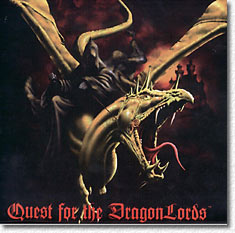
After the games fair in Essen we are again starting the slow process of trying out all new releases, in our "orc games sub division" group of the Westpark Gamers the focus is - of course - on fantasy games. I was the happy buyer of the 85th (of 1000) game of "Quest of the Dragonlords" for 2-4 players, which was released for the first time in Essen, and which looked like an interesting cross of Axis and Allies, Risiko and Talisman, , with a high "hack factor", as the "Knights of the Dinner Table" would put it.
The game presentation is absolutely stunning - hundreds of plastic figurines that depict, not surprising considering the genre, gigantic dragons, armies and fleets. 4 races (Elves, Orcs, Dwarves and Barbarians) fight for the control of a fantasy kingdom that is laid out on a nice but slightly confusing (regarding mountain borderlines, which are sometimes difficult to detect) map. There are some strange details: For example, Elves are RED and the orcs GREEN ("tradition" usually favors the other way round). Also notably different are the special abilities of some of the races - Elves are not noted for range strikes but for hobbit like sneak attacks here, but well, if you think of Celeborn's sneaky elves in the film.... And barbarians are especially good shipbuilders, well, they didn't watch "Conan" then!
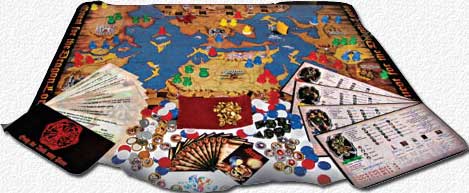 Setup works like in "Risk" - each player takes
turns placing single figures until the map is full, therefore creating different starting
situations. Especially important are "treasure" spaces (some on islands) and
"kingdoms" (gives you control of a colored region of "areas" -
important for army regeneration and income). But even "empty" spaces are
important - they more you have the more gold income you get, also not unlike Axis and
Allies. Another similarity to that game is the fact that armies bought at the beginning
of the turn are placed at the END of the turn, after hacking, so to speak.
Setup works like in "Risk" - each player takes
turns placing single figures until the map is full, therefore creating different starting
situations. Especially important are "treasure" spaces (some on islands) and
"kingdoms" (gives you control of a colored region of "areas" -
important for army regeneration and income). But even "empty" spaces are
important - they more you have the more gold income you get, also not unlike Axis and
Allies. Another similarity to that game is the fact that armies bought at the beginning
of the turn are placed at the END of the turn, after hacking, so to speak.
Gold is depicted in a very nice way - real "lumps" of gold are used, each look different and "natural", a good fantasy touch. The coloring used is very ....well, very little water and sweat resistant, so you have to get used to become a goldfinger like ol' King Midas.
Player "cheat sheets" are also produced lovingly - they are all different, and even expensively mounted, like the game board. They feature info on spells and turn sequence, there are even holes in which you can stick markers that show what spells you have (the holes are rather small for the plastic pieces used, but that is only a minor qualm - use "the force").
The aforementioned setup presents a small problem of the game - there are 6 "kingdom" spaces to start with, and everybody wants one first, so in a 4 player game players 3 and 4 will certainly only get ONE kingdom space, the others 2. Not only do they suffer the typical "Risk"-disadvantage of moving last, they also get less money to start with. No problem here for 3 or 2 players, though.
Now we start - each player's turn has several phases: First you buy armies, then you move fleets and dragonlords (which you won't have at start - it will be one of your main goals to find one of these very elusive guys!), then you move your quest parties through the wastelands (two specially separated adventure areas - when you enter them, your armies become adventurers seeking fame and magical power, when you leave the wastelands, your adventurers become armies again, hopefully more powerful). Then there is a kind of "combat move" like in "Risk" - attack to win, then you can move your victorious armies into the new territory...and beyond, if you want, to continue your attack!. Then there is a kind of "forced march", actually a special phase not named as such, and a "transfer move", which takes care of spaces that became empty, but weren't conquered. Then you collect income for your areas and place the armies you bought at the beginning.
The adventures in the wastelands are much fun - they give some role-playing flair, although everything is very simplified and basically is decided through one roll of the die, even when the "flavor-text of the adventure cards might make you think otherwise. But there is still some tactics involved - you have to have certain items to survive certain adventures, and there is always a choice to make if you want to lose time with equipping or boldly go into dangerous spaces. The center space is the dragon's cave - you need a certain "Talisman" to get a dragonlord there, and that's what you want, really. Why? Although some of the spells and items you can find in the wastelands are nifty, the dragonlord is the ultimate weapon - he can breathe fire to destroy fleets and armies, and he can teleport 10 armies ANYWHERE on the board (the rules dryly note that it doesn't make much sense to protect borders in this game - there is too much teleportation going on here...).
This is vital to ending the game more quickly than your usual fantasy monster game -the player who kills all the other "kings" (one army piece is declared to be "king" at the beginning of the game - protect it at all costs, mate!) wins the game (you can also win by conquering all kingdoms, but that is very difficult).
This is always a slight problem in a game: eliminated players will have to idly sit and watch - the designers have hinted at publishing alternate victory conditions soon, which will be interesting. We usually stop when one player is eliminated in our group.
Our first game thus actually ended in the first round - before the 3rd and 4th player had moved at all! One player hadn't expected that armies and fleets can practically reach any space on the board, and had placed her king alone! The second game was also over quite quickly, but this came through a misunderstanding from my side of the rules, which made the attacker too powerful in a combat. But it was me who was eliminated, so I was punished for this oversight!
Our impression was that "Quest..." is an interesting and fun game - it might not win a prize for originality, as most game mechanisms are known from other games, but the clever combination of these elements creates a fast moving (compared to other games of the fantasy battles genre- we're not talking "Liar's Dice" here!) game with an "epic" feeling, I guess around 3-4 hours if played correctly. The presentation creates a lot of flair, you can really annoy other players, and the splatter factor is high. The price is VERY good when you look at the game components, and it is clear that a lot of love went into the production. The game rules are even additionally presented on CD (with animated examples) - which is pure luxury, really.
Westpark-Gamers say: Recommended!
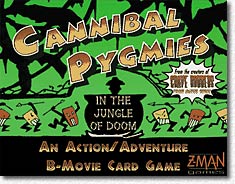
Auch dies eine Messeneuheit, das Nachfolgespiel zu "Grave Robbers from Outer Space". Dieses recht einfache Kartenspiel evoziert die Welt der B-Filme in all ihrer Glorie, diesmal mit speziellem Augenmerk auf "Dschungel"-Abenteuer-Filme (Tarzan lässt grüßen).
Jeder Spieler ist ein Filmproduzent, und versucht "seine" Version des Films aufzubauen, mit eigener "Location", und verschiedenen "Characters", die auch "props" besitzen. Alle diese Karten haben Punktwerte, die sich zu einem gesammelten "Defense"-Wert addieren. Dieser ist auch potentieller Punktestand für den Sieg, wenn die Karte "Roll Credits" gespielt wird. Es gibt allerdings noch eine zusätzliche Punktequelle, nämlich den Filmtitel - am Anfang des Spiels wird aus 6 zufällig gezogenen Karten ein möglichst bizarrer Titel zusammengestellt (in unserem Fall war das "The Mystic Portal of Egypt versus the valley of the volcano amazons" (nun, vielleicht ein bisschen zu lang, um im Kino erfolgreich zu laufen). Jede Karte, auf der Hand oder im Spiel, die einen Teil dieses Titels trägt, bringt 5 Bonuspunkte, muss also eine der ursprünglich gezogenen Karten sein.
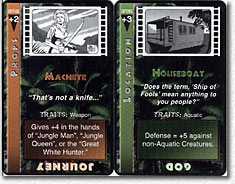 Im Spiel benutzt man Monsterkarten sowie SFX-Karten (letztere sind hundertmal
schlimmer, denn sie können IMMER gespielt werden), um die Filme der anderen Spieler
anzugreifen. Hierbei wird Gott sei dank nicht gewürfelt, sondern einfach nur Angriffs-
und Verteidigungswert miteinander verglichen. Alle Spieler können SFX-Karten spielen, um
das Ergebnis zu beeinflussen. Siegt der Angreifer, stirbt ein "Darsteller". Und
man staunt - 80% aller Angriffe sind erfolgreich, denn die Monster sind nicht gerade
schwächlich!
Im Spiel benutzt man Monsterkarten sowie SFX-Karten (letztere sind hundertmal
schlimmer, denn sie können IMMER gespielt werden), um die Filme der anderen Spieler
anzugreifen. Hierbei wird Gott sei dank nicht gewürfelt, sondern einfach nur Angriffs-
und Verteidigungswert miteinander verglichen. Alle Spieler können SFX-Karten spielen, um
das Ergebnis zu beeinflussen. Siegt der Angreifer, stirbt ein "Darsteller". Und
man staunt - 80% aller Angriffe sind erfolgreich, denn die Monster sind nicht gerade
schwächlich!
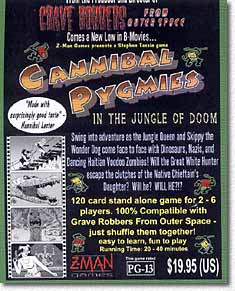 Das Spiel besteht vor allem aus den komplexen Karteninteraktionen -
praktisch alle Karten im Spiel haben einzigartige Sonderfähigkeiten, die die Regeln
brechen können, manchmal ist es gar nicht einfach, den Überblick zu behalten! Der
Chaosfaktor ist extrem hoch - kaum hat man mal mühsam 1 oder 2 Darsteller in seinen Film
gebracht, schon verschlingt sie irgendein Monster oder irgendein Spezialeffekt, die
meisten Züge beginnen damit, dass man seinen gesamten Film erst wieder aufbauen muss, was
einem anhand der mehr oder weniger guten gezogenen Karten mehr oder weniger gut gelingt.
Es macht ohnehin keinen Sinn, irgendwelche Karten (außer der Bonuskarten) aufzuheben,
denn ständig verliert man seine Kartenhand, bekommt einzelne Karten weggenommen, etc.).
Daher gibt es auch keine längerfristigere Strategien - es zählt allein der Spaßfaktor der
im 50er-Jahre-Comic-Stil gezeichneten Karten. Das ist beim ersten Spiel vielleicht ganz
nett, weil die Karten neu sind, wird aber sicherlich beim mehrmaligen Spielen mühsam und
langweilig.
Das Spiel besteht vor allem aus den komplexen Karteninteraktionen -
praktisch alle Karten im Spiel haben einzigartige Sonderfähigkeiten, die die Regeln
brechen können, manchmal ist es gar nicht einfach, den Überblick zu behalten! Der
Chaosfaktor ist extrem hoch - kaum hat man mal mühsam 1 oder 2 Darsteller in seinen Film
gebracht, schon verschlingt sie irgendein Monster oder irgendein Spezialeffekt, die
meisten Züge beginnen damit, dass man seinen gesamten Film erst wieder aufbauen muss, was
einem anhand der mehr oder weniger guten gezogenen Karten mehr oder weniger gut gelingt.
Es macht ohnehin keinen Sinn, irgendwelche Karten (außer der Bonuskarten) aufzuheben,
denn ständig verliert man seine Kartenhand, bekommt einzelne Karten weggenommen, etc.).
Daher gibt es auch keine längerfristigere Strategien - es zählt allein der Spaßfaktor der
im 50er-Jahre-Comic-Stil gezeichneten Karten. Das ist beim ersten Spiel vielleicht ganz
nett, weil die Karten neu sind, wird aber sicherlich beim mehrmaligen Spielen mühsam und
langweilig.
Gewinnen tut man nur dann, wenn man 1) Gute Karten in der Runde ausspielen kann 2) die "Roll Credits"-Karte besitzt und spielt. Dies kann man auf keinen Fall vorausplanen, es ist pures Glück.
Zudem dauerte das Spiel extrem lang - manche Karteneffekte verhindern "Roll Credits", und so kann sich das Chaos ewig (zumindest ZU ewig für ein kleines Kartenspiel) hinziehen.
Dennoch: Für Fans der Thematik ein nettes Spielchen, und die Karten sind wirklich lustig. Ansonsten spielerischer Durchschnitt.
Dieses Spiel wird spannender und besser, desto öfter man es spielt! Diesmal traten Darth Vader und Count Dooku, sicherlich die beiden mächtigsten Charaktere der dunklen Seite, gegen Anakin Skywalker und Han Solo an. Da wir inzwischen die Karten immer besser kennen, wird das Spiel immer taktischer, zudem spielten wir mit einer kleinen Variante, die es erlaubt, immer eine Karte des Teampartners zu sehen.
Count Dooku wagte sich gleich am Anfang zu weit vor, und konnte durch eine glückliche Kombination von Anakins Spezialkarten unschädlich gemacht werden. Doch auch Han Solo starb kurz darauf durch eine Kugel eines Nebencharakters. Nun galt es, Darth Vaders Sturmtruppen unschädlich zu machen, um einen Spieler auszuschalten (und damit einen Kartenvorteil zu erlangen). Dies gelang, doch letztlich führte allein die Zähigkeit Chewbaccas zum Sieg der Guten - Anakin war schon kurz am Abnippeln bevor Chewbacca den rettenden Armbrustschuss tat.
Da hat Darth Vader sich also letztlich selber umgebracht, oder zumindest dabei geholfen!
Dies kann nur bei EPIC DUELS geschehen!